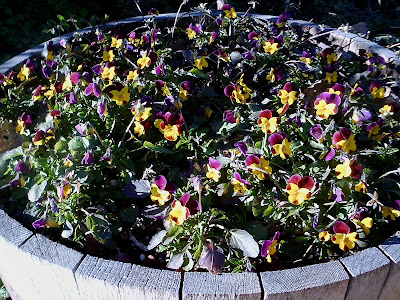We were quite impressed with the simple beauty and tranquility, but even more so with the garden's authenticity, especially in such a short time of preparation.
We had done a little research before going, so we knew what to expect:
Though often thought of as tranquil sanctuaries that allow individuals to escape from the stresses of daily life, Japanese gardens are designed for a variety of purposes. Most gardens invite quiet contemplation, but may have also been intended for recreation, the display of rare plant specimens, or the exhibition of unusual rocks.
Kaiyu-shiki or Strolling Gardens require the observer to walk through the garden to fully appreciate it. A premeditated path takes observers through each unique area of a Japanese garden. Uneven surfaces are placed in specific spaces to prompt people to look down at particular points. When the observer looks up, they will see an eye-catching ornamentation which is intended to enlighten and revive the spirit of the observer. This type of design is known as the Japanese landscape principle of "hide and reveal".
Traditional Japanese sensibility attests that stones are actual beings with spirits that need to be treated with reverence. Stones are used to construct the garden's paths, bridges, and walkways. Stones also represent mountains where actual mountains are not viewable or present. They are always placed in odd numbers and a majority of the groupings reflect triangular shapes.
A water source in a Japanese garden should appear to be part of the natural surroundings; this is why one will not find fountains in traditional gardens. Man-made streams are built with curves and irregularities to create a serene and natural appearance. Lanterns are often placed beside some of the most prominent water basins (either a pond or a stream) in a garden representing the female and the male elements of water and fire. In Japanese tradition this is known as yin and yang. In some gardens one will find a dry pond or stream. Dry ponds and streams have as much impact as do the ones filled with water.
Green plants are the third element of Japanese gardens. Japanese traditions prefer minimal color so the use of flowers is generally parsimonious. Plants with colorful blooms are mostly used near a garden's entrance. Many plants in imitated Japanese gardens of the West are indigenous to Japan, though some sacrifices must be made to account for the differentiating climates. Some plants, such as sugar maple and firebush, give the garden a broader palette of seasonal color.
And true to Japanese Garden tradition, first we enjoyed the beautiful Tea house pagoda.(Click on photos for larger views)

Immediately upon walking through the large wooden gates into the garden, our ears were filled with the music of water. Several small waterfalls, creeks, and even a large waterfall beckoned us to walk among the twisting, meandering paths and unique rockscapes.

We had a great time skipping over the small boulders strewn across creeks and waterways.

My favorite things were the unique stone lanterns, or tachi-gata, in Japanese, which means "pedestal stone lanterns". They made such a strong, yet fitting statement in the garden. I think I may have to find a stone lantern of my own to place in our garden at home.



I was struck by the strength of this statue and the way it jutted into the bright blue sky.

The kids liked it, too and begged for a photo of them with the statue.

The main waterfall rushes down into a tranquil pond, which I assume will be (if not already) filled with koi and turtles. What a treat. This area just begged us to sit, meditate, relax, or just read a book. Beautiful place. Can't wait to go back again.

After we left the Japanese garden, we decided to visit the Heritage Farm and Gardens. And couldn't help but admire some pretty little pansies in a country barrel.

This acre sign interested Jackson & Jeremiah because we finally do own some acreage in our beautiful mountains. The description on this sign and perspective of this field gave them a good idea of what an acre looks like and how it came to be called an acre. (Click photo to read sign)

No visit to the farm is complete without visiting the chickens. Now that we are planning our own chicken coop, getting ideas are helpful. We only have a couple more weeks before our chickens will be busting out of their mini-coop in the garage, and needing more space. I love the rustic style of the Bio Park's chicken coop, and we have alot of juniper and cedar branches out here in the mountains.Maybe we could build something similar?

Another coop view.


1 comment:
I didn't know about the Japanese garden, it sounds terrific, we'll have to go!
-Astro D/ Diane
Post a Comment